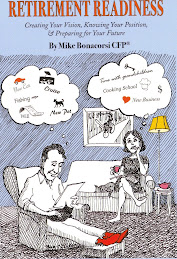What is the difference between a strategy and plan in charting your course for retirement? Strategies are the options you might follow to meet different goals. A plan is a global document that encompasses a number of goals equally and consists of action steps that help you to meet those goals.
I was reminded of this difference recently when reviewing the “plan” created by Lou, a friend of mine. Lou asked if I would, “take a look” at his plan and offer an opinion. He handed me a document that was several pages long, which contained the results of a risk analyzer and portfolio recommendations. I could see that he had spent some time creating this.
I immediately thought of the difference between strategies and plans and said, “This is interesting as a strategy, but lacking as a plan.” He looked puzzled at my comment and I went on to explain, a true financial plan is a life plan. It starts with a vision of how you see your future, creating goals, setting priorities.
Once your goals are set, then you develop strategies. These should consist of more than building a portfolio. Strategies are the engine that drives you to your vision. They are the action steps that lead you to meet your goals. They must be comprehensive to be truly effective. Like an engine, which cannot run efficiently on a few cylinders, throwing together various strategies, without a global plan, will only get you spotty results and ultimately misfires. Strategies include creating timelines, understanding all areas of money management, insuring and protecting against catastrophe, and creating a Plan B for the unexpected.
A plan is an active document--an evolving project--which requires monitoring, tweaking and updating. Changes in your job, relationships, health, and financials will necessitate updates and adjustments. When priorities change, one goal may be accomplished, while another is added to replace it. For instance; the birth of a child or grandchild, may add college planning to the plan, or health issues may require additional care costs. Changes in relationships may require revamping your estate planning goals.
When the plan is active and not set in stone, you can easily readjust and keep moving forward. Making sure you stay on target to your goals will require vigilance. You will be updating and rebalancing your accounts, making adjustments in your strategies, and revisiting your timelines.
Try thinking of building a life, or financial, plan along the lines of taking a long journey. First, you have a vision of the trip, decide upon the various stops along the way, and then chart the route you will travel. Your vision becomes stronger, once you have that map out, the car goes into the garage for a tune-up, and the hotels are booked. Once begun, the journey is likely to follow twists and turns you didn’t plan for and yet they add to the value of the experience. The restaurant you found on the back street when you took a wrong turn, the bad weather that caused you to postpone the canyon hiking for a trip to an antique shop full of bargains, all contribute to the evolving nature of an active journey. It’s always changing and that allows you to make the best of whatever comes your way.
As you build your life/financial plan, keep these thoughts in mind:
Start with a vision.
1. Set timelines for goals.
2. Create strategies that align with your goals.
3. Monitor, adjust, rethink, tweak.
4. The destination you reach may be more wonderful than you ever imagined.
About Mike Bonacorsi, CFP®
Mike Bonacorsi is a CERTIFIED FINANCIAL PLANNER™ professional, public speaker and award-winning author of Retirement Readiness: A Guide to Creating Your Vision, Knowing Your Position, and Preparing for Your Future. You can listen to his radio show, The Mike Bonacorsi Show, at WSMN, 1590AM or on your computer at http://wsmnradio.com on Tuesdays from noon – 1:00 PM. For additional information, visit http://mikebonacorsi.com/. Reprinted with permission of the author. 2009© Mike Bonacorsi CFP® All Rights Reserved.

Two Minute Retirement Readiness Tips
Monday, June 1, 2009
Financial Planning is More Than Money: How strategies fit into Plans
Labels:
advice,
baby boomer,
books,
expert advice,
finance,
income,
investing,
money,
retirement,
Retirement Readiness,
social security

